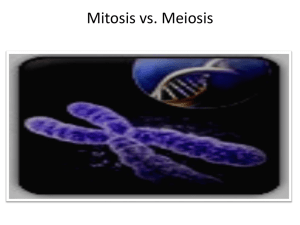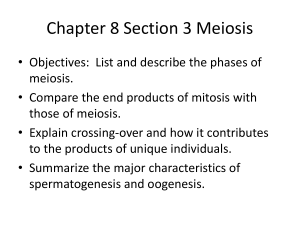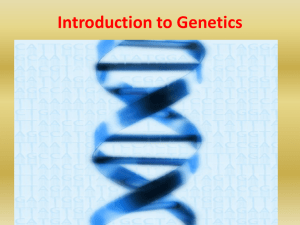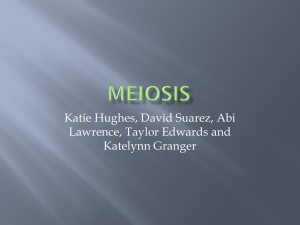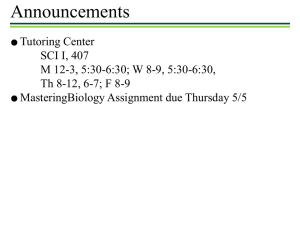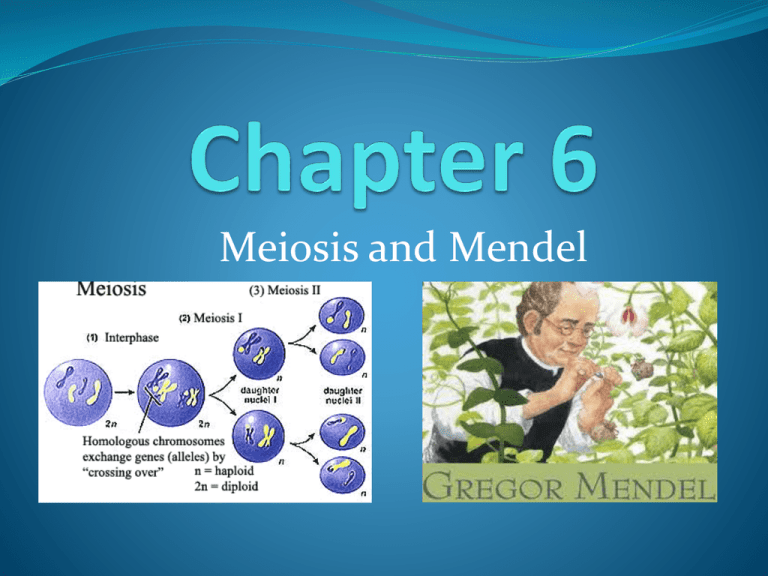
Meiosis and Mendel
Section 6.1- Chromosomes
You have many different types of cells in your body, but
there are only 2 general types.
The differences in these two is the amount of
chromosomes in them.
Somatic Cells
Gamete Cells
Section 6.1- Chromosomes
Somatic Cells
Are also called body cells
These are the cell that make up
your body tissues and organs
Everything from eyeballs to your
heart
Your body cells are not passed on
to offspring
Somatic cells are DIPLOID!
Skin Cells
Section 6.1- Chromosomes
Gamete Cells
These are sex cells
The sex cells are eggs in females and sperm in males
The two cells come together to make the 1st cell of a new
human being.
Gamete cells are HAPLOID!
Section 6.1- Chromosomes
All organisms have a different number of
chromosomes per cell.
The number of chromosomes; however,
is not related to the complexity of the
organism.
For example, yeast have 32 chromosomes
and a fern plant has 1200 chromosomes.
Humans have 46 chromosomes that
come in 23 pairs.
The diploid number for humans is 46
and the haploid number is 23.
Section 6.1- Chromosomes
So, in each cell in your body
(except your sex cells) you have
46 chromosomes.
These 46 chromosomes come
in 23 sets, and for each set one
chromosome came from your
mother and one came from
your father.
Together, each pair of
chromosomes is known as a
homologous pair.
Section 6.1- Chromosomes
homologous chromosomes are two chromosomes
that have the same general shape and structure.
One of these came from the mother and the other from
the father.
Most importantly, these homologous chromosomes
have copies of the same genes on them.
These copies may be different copies, but they are
copies of the same gene.
Section 6.1- Chromosomes
Of the 23 pairs of chromosomes we have, the first 22
pairs are known as autosomes.
These are chromosomes that contain genes for
characteristics not directly related to the sex of an
organism.
The chromosomes in the first 22 pairs code for
everything except sex.
Section 6.1- Chromosomes
The 23rd pair of chromosomes are called your sex
chromosomes.
This pair controls what sex that organism is going to
be.
The two possible sex chromosomes are “X” and “Y”.
If an organism has “XX” pair, that organism is a female.
If an organism has “XY” pair, that organism is a male.
If you are a male- your 23rd set of chromosomes are not
homologous because they are not identical.
Section 6.1- Chromosomes
Males determine the sex
of an offspring because
they are the only one that
can give a “Y”
chromosome.
When sexual
reproduction occurs, two
gametes come together
resulting in a genetic
mixture of both parents.
This is called
fertilization.
Section 6.1- Chromosomes
This 1st cell of the new organism must have the correct
number of chromosomes (46 in humans).
This is why all sex cells are in the haploid condition.
This means that these cells only have one copy of the
homologous pair.
If these cells were diploid, (which is the full number of
chromosomes), when they came together during
fertilization there would be double the number of
chromosomes needed (92 in humans).
This would cause mass mutations and spontaneous abortion
of the cell.
Section 6.1- Chromosomes
The correct number of chromosomes must be
maintained for the organism to survive.
Also remember that having too many chromosomes is
just as harmful as not enough.
Down Syndrome- caused by the presence of an extra
chromosome 21
Patau Syndrome- caused by the presence of an extra
chromosome 13
Turner’s Syndrome- children only have one X chromosome
and no Y chromosome, so they have only 45 chromosomes.
Section 6.1- Chromosomes
How do organisms maintain chromosome numbers?
How do sex cells have a different number of
chromosomes than all other cells?
Section 6.1- Meiosis
Meiosis is similar to mitosis in that it is a form of
nuclear division.
However, unlike mitosis, meiosis reduces the number
of chromosomes to haploid numbers.
Sex cells undergo cellular division called MEIOSIS
Section 6.1- Meiosis
Mitosis and Meiosis both divide the nucleus but there
are differences!
MITOSIS:
•Produces identical cells
•Results in diploid cells
•Takes place all through life
MEIOSIS:
•Produces unalike cells
•Results in haploid cells
•Occurs only at certain times
Meiosis’s most important feature is that it reduces the
number of chromosomes in half so when a sperm and
egg come together, the diploid number is restored.
Section 6.2- Process of Meiosis
One round of meiosis yields 4 unidenitcal sex cells
from one diploid cell.
The chromosomes get reduced because meiosis goes
through division twice.
Meiosis’s phases are the same in name as mitosis;
however, there are two rounds of division without any
replication between meiosis I and meiosis II.
Section 6.2- Process of Meiosis
Meiosis I:
Prophase I
Metaphase I
Anaphase I
Telophase I
Meiosis II:
Prophase II
Metaphase II
Anaphase II
Telophase II
Section 6.2- Process of Meiosis
In Meiosis I, paired homologous chromosomes split
and in meiosis II the duplicated chromosomes split
so you end up with 4 unidentical cells in the haploid
condition.
The initial cell has 4 chromosomes and the 4 cells in
telophase II have 2 chromosomes.
Section 6.2- Process of Meiosis
Haploid cells are the end result
of meiosis
However, these cells are not yet
ready to fertilize and must go
through more changes that
“mature” the cell.
In sperm production, all sperm
cells formed from meiosis are
functional and ready to
fertilize.
In egg production, only 1 out of
every 4 cells become an egg
because as meiosis occurs the
cytoplasm divide unevenly.
Section 6.3- Mendelian Genetics
When we talk about differences among organisms, we
talk about their traits.
TRAITS are characteristics that are inherited.
GENETICS is the study of how these traits get passed
on from parent to offspring
Section 6.3- Mendelian Genetics
Initial studies in genetics
started in the mid 1800’s
by an Austrian monk
named GREGOR
MENDEL.
Most scientist believed at
this time that offspring
were a blend of their
parents.
For examples, if one
parent was tall and one
was short, then the
offspring would be
medium in size.
Section 6.3- Mendelian Genetics
Mendel didn’t believe this theory because there were
too many traits that remained “undiluted”
meaning they were not blends.
So, Mendel started doing thousands of test crosses
breeding plants.
He was a mathematician by trade so he analyzed all of
these results.
Mendel primarily used the pea plant because
It reproduced quickly
Its traits were easy to see
Section 6.3- Mendelian Genetics
As Mendel started his studies, he took over the monastery
garden.
He made sure to use only purebred pea plants to start with
This way he knew what the traits were for all his starting pea
plants.
Purebred means both copies of a gene are the same
We represent genes with letters.
Purebred:
TT
Tt
Rr
RR
Section 6.3- Mendelian Genetics
Remember Mendel chose pea plants because they
reproduce quickly.
He could also control how they mated.
He allowed certain plants to self-pollinate over and
over again until he was sure he had purebred plants.
It was vital that Mendel start his experiments with
purebreds so he knew what he had at the beginning.
Section 6.3- Mendelian Genetics
Mendel than removed the male part of the plant of
his purebreds
he then could control what plant pollinated what
plant.
In doing this Mendel knew any variation in pea plant
offspring was a result of his experiment and not any
other random crossing.
Section 6.3- Mendelian Genetics
Mendel chose 7 specific
traits to follow:
Pea Shape
Pea Color
Pod Shape
Pod Color
Plant Height
Flower Color
Flower Position
Section 6.3- Mendelian Genetics
All of the traits
Mendel looked at
were simple “EitherOr” traits.
Plant height= tall
or short
Pod shape=
smooth or
constricted
Section 6.3- Mendelian Genetics
In genetics, when you mate two organisms, this is
called a cross.
The 1st plants Mendel started with is the P1
generation or parental.
The offspring of the P1 is called F1 (filial).
Offspring of F1 is the F2 and so on….
Section 6.3- Mendelian Genetics
Mendel took all 7 of the traits he indentified and
crossed the two purebred conditions for each trait.
Round x Wrinkled
Yellow x Green
Smooth x Constricted
Green x Yellow
Tall x Short
Purple x White
Axial x Terminal
Section 6.3- Mendelian Genetics
What Mendel found in the (F1) was that all the
offspring looked like one of the two parents and the
trait of the other parent seemed to disappear.
Tall x Short = ALL TALL
Purple x White = ALL PURPLE
Section 6.3- Mendelian Genetics
Mendel then allowed his F1
plants to self- pollinate and
what he discovered was
that most of the offspring
(F2) looked like the
parents, but a small
percentage of them looked
like the P1 parent whose
characteristic disappeared
in the F1.
There was about ¾ of the
offspring that looked like
F1 and ¼ that looked like P1
parent that disappeared.
Section 6.3- Mendelian Genetics
Summary of what Mendel has done to this point:
P1 Cross:
Tall Plant x Short Plant
F1:
All tall plants
F1 plants are allowed to
self-fertilize
F2:
¾ Tall Plants
¼ Short Plants
Section 6.3- Mendelian Genetics
From these initial crosses, Mendel came up with 3
important conclusions:
Traits are inherited separately as discrete units
Organisms inherit 2 copies of a gene, one from each
parent
Organisms donate only one copy of each gene in their
gametes, so genes separate upon gamete formation
Section 6.3- Mendelian Genetics
The last two points make up the LAW OF
SEGREGATION
Genes of traits don’t stick together
We will learn why this is in the following sections when
we start doing crosses!



